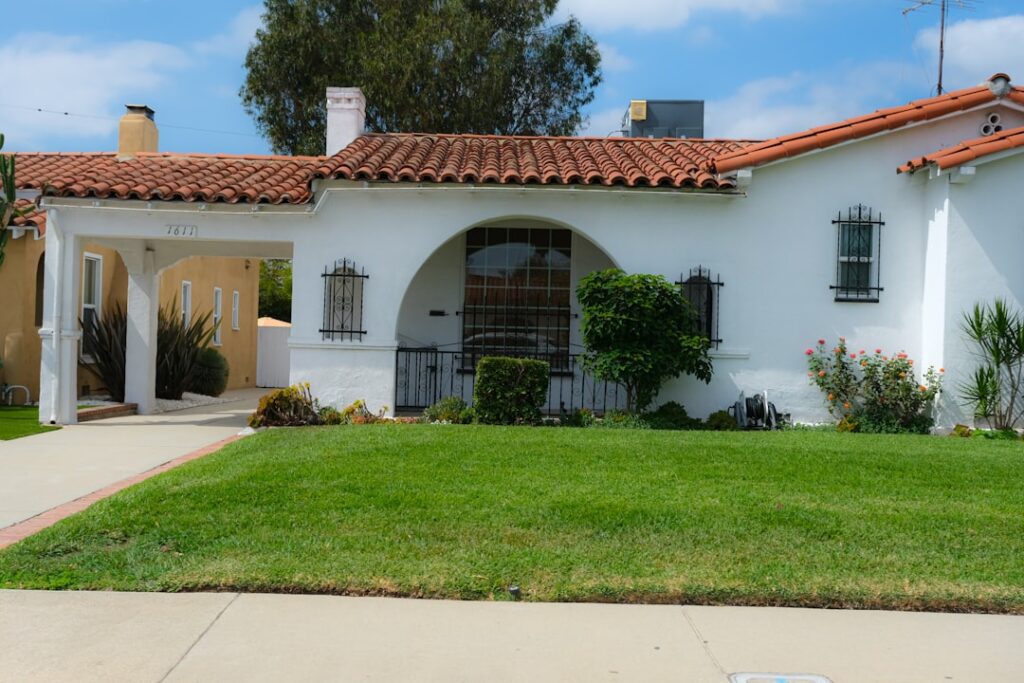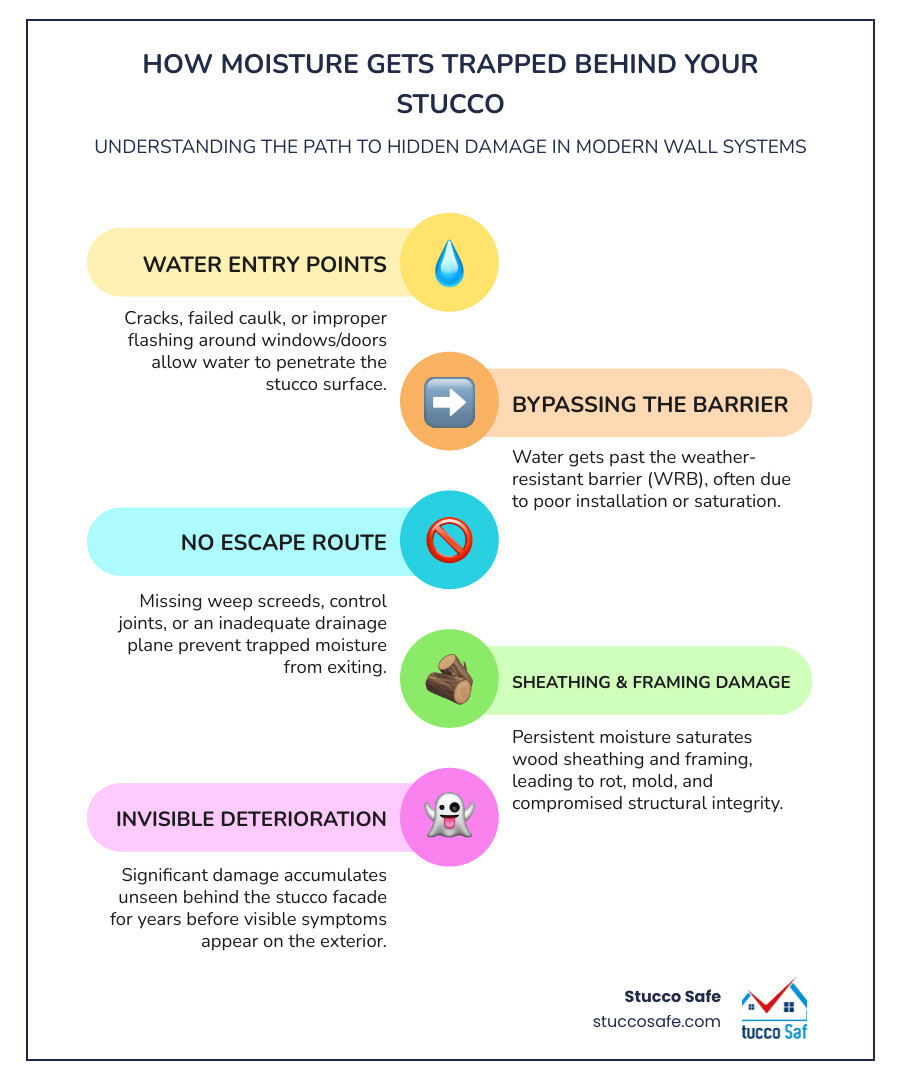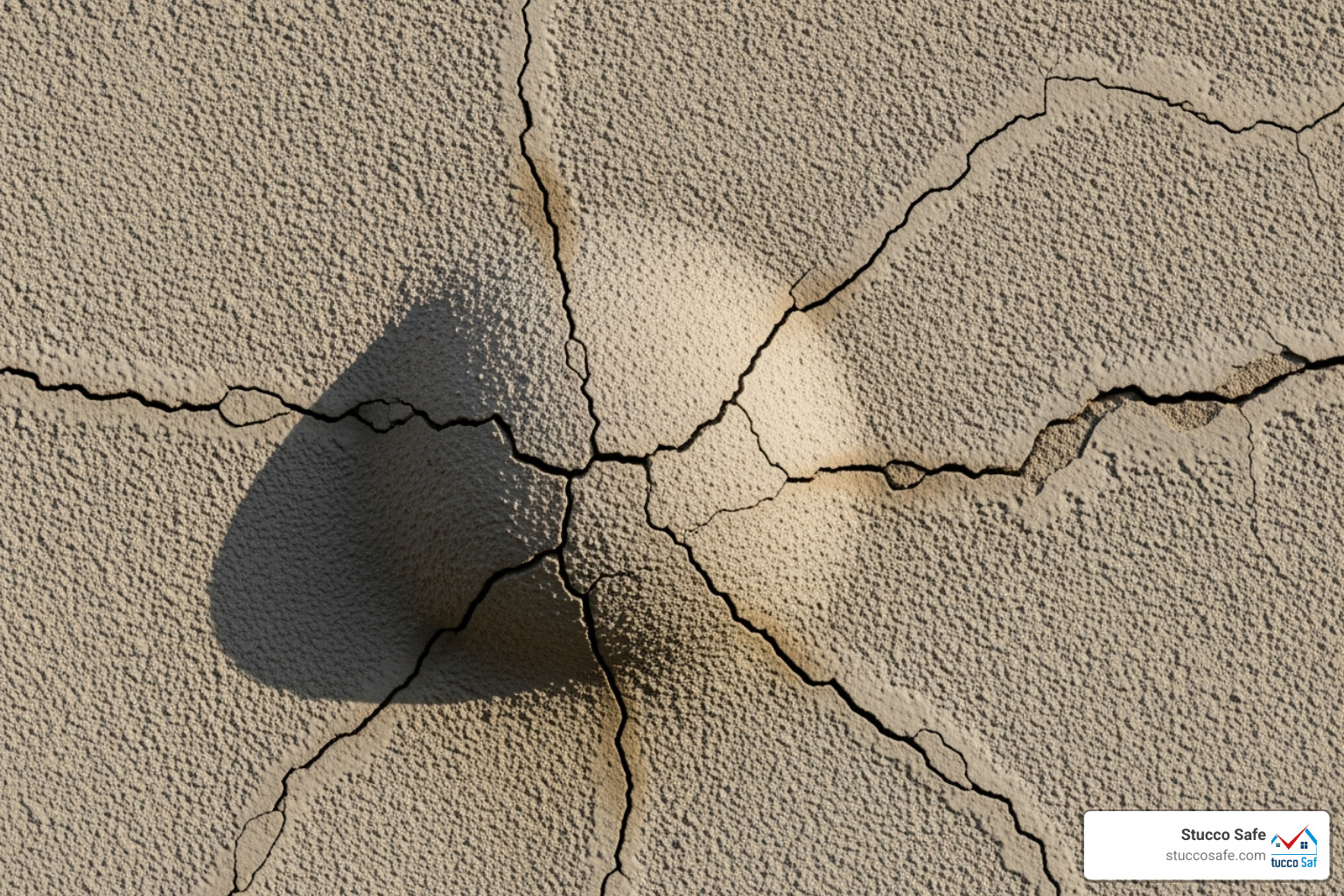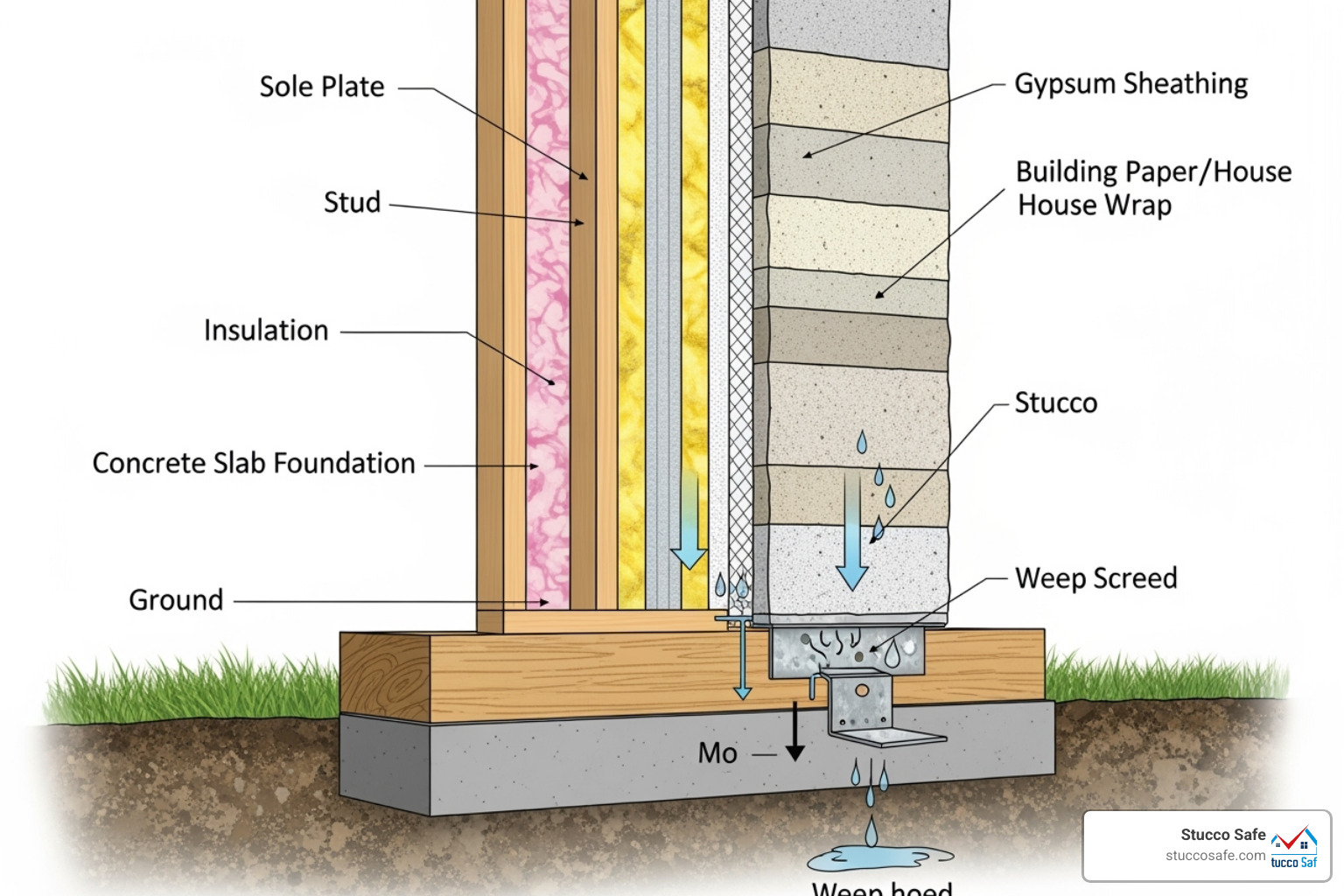Stucco Exterior Wall Problems: 1 Urgent Warning
Why Stucco Exterior Wall Problems Are More Serious Than They Look
Stucco exterior wall problems can range from minor cosmetic cracks to catastrophic hidden moisture damage that threatens your home’s structural integrity. Understanding what to watch for is critical, because by the time you notice visible symptoms, serious damage may already be underway behind your walls.
Common stucco problems include:
- Cracks – Hairline cracks, diagonal cracks, or stairstep patterns
- Water stains – Dark streaks, or green, black, or white discoloration
- Bulging or soft spots – Areas where the stucco feels spongy or has separated from the wall
- Mold and mildew – Musty odors or visible growth
- Peeling paint – Paint that repeatedly fails despite proper application
The biggest challenge is that serious damage is often invisible from the outside. Moisture can infiltrate through tiny cracks, get trapped, and rot your home’s wood framing for years. Homes built between 1985 and 2003 are particularly vulnerable due to outdated building codes and cheap materials used during Pennsylvania’s construction boom.
In wet climates like the Northeast, high rainfall and freeze-thaw cycles create a perfect storm for stucco failure. A small crack can lead to tens of thousands in remediation costs if water reaches the sheathing and framing.
I’m Gabe Kesslick, and I’ve been investigating and repairing stucco exterior wall problems since 2001 as an EDI Level 2 Certified Stucco Inspector and BESI Level 2 Certified Building Envelope Forensic Inspector. Through Stucco Safe, I’ve helped hundreds of homeowners in Southeastern Pennsylvania identify hidden moisture issues before they become structural nightmares.
Visual Warning Signs: How to Spot Stucco Failure Early
When it comes to stucco exterior wall problems, your home’s exterior provides warning signals. Recognizing these signs early can save you from catastrophic damage and costly repairs.
Telltale Cracks
Why is my stucco cracking? It’s a common question. While all stucco develops some cracks, it’s crucial to know if they are harmless or dangerous. Normal movement and curing can cause minor cracks, but if the stucco was installed improperly, even small cracks can let water in.
The critical difference between harmless and harmful stucco cracks comes down to size, pattern, and behavior:
| Minor Cosmetic Cracks | Serious Structural Cracks |
|---|---|
| Appearance: Hairline, spiderweb patterns, or small, isolated cracks. | Appearance: Diagonal cracks (especially from window/door corners), stairstep patterns (in block or brick below stucco), wider than 1/16 inch. |
| Size: Generally less than 1/16 inch in width. | Size: Wider than 1/16 inch, growing over time, or multiple interconnected cracks. |
| Cause: Normal drying shrinkage, minor thermal expansion/contraction, or superficial application issues. | Cause: Foundation settlement, significant structural movement, or severe water damage behind the stucco causing rot. |
| Implication: Primarily aesthetic. Can be sealed with masonry caulk. | Implication: Indicates underlying issues that require professional assessment. Ignoring these can lead to significant structural damage. |
| Reappearance: May reappear after patching but without worsening. | Reappearance: Likely to reappear and worsen if the underlying issue is not addressed. |
Diagonal cracks radiating from window corners are a major red flag, often signaling foundation movement or rot in the framing. Stairstep cracks also suggest foundation shifting. A growing diagonal crack demands immediate professional attention.
Stains, Streaks, and Discoloration
Stains on your stucco are evidence of moisture problems.
- Dark streaks running down from windows or rooflines indicate water is flowing where it shouldn’t, usually due to failed flashing.
- Green or black spots are mold and mildew, which thrive in moist, shaded areas and can hint at deeper saturation.
- A white, chalky substance (efflorescence) is a clear sign that water is moving through the wall, dissolving salts, and leaving them behind as it evaporates.
Pay special attention to stucco water stains around window corners, under eaves, and near chimneys.
Bulging, Bubbling, or Soft Spots
When stucco bulges, bubbles, or feels soft, it’s an urgent warning sign of advanced stucco siding problems.
Bulging stucco (delamination) means water has gotten behind the coating, causing the wood sheathing to swell or rot. Bubbling occurs when trapped moisture tries to escape. Our guide on bubbling stucco: a guide to prevention and repair covers this issue.
Most concerning are soft spots. If you press on the stucco and it feels spongy, the wood sheathing or framing behind it is likely rotting. This is a structural emergency.
Mold, Mildew, and Insect Infestations
Moisture behind stucco invites unwanted guests.
A persistent musty smell inside or visible mold on interior walls indicates a significant moisture breach. We offer inspector for mold services to assess contamination.
Termites and carpenter ants are drawn to water-damaged, softened wood. An insect problem is often a symptom of a moisture problem. This is why stucco remediation, mold and termites often go together. If you see pests, call an exterminator and a stucco inspector to address the root cause of the stucco exterior wall problems.
Understanding the Root Causes of Stucco Exterior Wall Problems
Understanding why stucco exterior wall problems happen is key to protecting your home. Most issues stem from trapped moisture, often due to installation flaws. If you’ve wondered what are the problems with stucco houses?, the answer usually involves water.
The #1 Culprit: Trapped Moisture
Trapped moisture is the villain in nearly every story. Stucco is porous and designed to breathe, but problems start when water gets behind it and can’t escape. Here’s how:
- Improper flashing: Flashing (thin metal around windows, doors, and rooflines) directs water away. If it’s missing or poorly installed, water flows directly into your wall cavity.
- Failed caulking: Caulk seals joints but degrades over time. Cracked or shrinking caulk creates tiny entry points for water.
- Roof and gutter problems: Clogged or missing gutters cause water to cascade down walls, overwhelming the stucco system and funneling moisture into the structure.
- Stucco below grade: Stucco should never touch the soil. When it does, it wicks ground moisture like a sponge, leading to severe moisture problems with stucco and wood rot.
Flawed Installation and Construction Defects
Many stucco exterior wall problems are direct results of stucco construction defects from when the home was built.
- Missing weep screed: This critical component at the bottom of a stucco wall allows trapped moisture to drain out. Without it, water pools and soaks the framing.
- No control joints: These planned breaks in the stucco accommodate expansion and contraction, preventing random cracking. Without them, large, uncontrolled cracks will form.
- Inadequate lath and thickness: The wire lath must be securely fastened, and the stucco applied to the proper thickness (around 7/8 inch). If not, the stucco can separate from the wall.
- Cheap materials: Many homes built in Pennsylvania in the 1990s and 2000s used inferior imported materials that are now failing.
Climate and Environmental Factors
Your local environment plays a huge role.
The Northeast climate is tough on stucco, with high rainfall, humidity, and freeze-thaw cycles. Water absorbed by stucco expands when it freezes, widening cracks and allowing more moisture in.
Modern building science has created more energy-efficient, airtight homes. While good for utility bills, this can trap moisture inside walls, preventing them from drying out. The wetting potential in our climate often exceeds the drying potential of modern walls, making proper installation of stucco on homes in the Northeast more critical than ever.
Minor Fix vs. Major Remediation: Assessing the Severity
When you find stucco exterior wall problems, the key question is: Is this a minor fix or a major remediation? Knowing the difference is crucial. Our stucco remediation guidelines can help you make this assessment.
Distinguishing Cosmetic Issues from Structural Concerns
Some stucco problems are minor. Sealing stable hairline cracks (thinner than 1/16 inch) or repainting with a vapor-permeable paint are reasonable DIY maintenance tasks.
When to DIY: Handle small, stable cracks or surface-level cleaning if you have the right materials. However, if you’re repeatedly patching the same area, it’s a sign of a deeper issue.
When to call a professional: Immediately call for help if you see cracks wider than 1/16 inch (especially diagonal or stairstep patterns), bulging or soft spots, persistent staining, or signs of mold or pests. A poor DIY repair on a serious problem only masks the symptoms while the damage spreads.
The Consequences of Ignoring Serious Stucco Exterior Wall Problems
Ignoring serious stucco exterior wall problems is a costly mistake. What starts as a small issue can become a six-figure nightmare.
- Hidden wood rot: Trapped moisture destroys the wood sheathing and framing that supports your home. The image above shows the blackened, rotted wood we often find when removing failing stucco.
- Compromised structural integrity: Rotting wood can’t support your home, leading to sticking doors, uneven floors, and interior wall cracks.
- Interior water damage: Moisture eventually pushes inside, saturating insulation, damaging drywall, and promoting mold growth that affects your family’s health.
- Expensive remediation costs: Waiting turns a localized repair into a full remediation project, which can cost $75,000 to $150,000 or more. It can take 7-8 years for serious issues to become visible, but the damage is accumulating the entire time.
When is Stucco Remediation Necessary?
Full remediation is a major undertaking, but it’s the only solution when there is widespread system failure. It becomes necessary when:
- Widespread failure is found: Our certified moisture testing reveals high moisture readings across large sections of the exterior.
- Structural damage is confirmed: Invasive testing verifies wood rot or compromised framing.
The remediation process is comprehensive:
- Tear-off: All failing stucco is removed to expose the underlying structure.
- Sheathing Repair: Rotted wood is removed and replaced.
- New Weather Barrier: A modern, properly installed weather-resistant barrier (WRB) and drainage plane are installed to manage water.
- Proper Re-cladding: New stucco or siding is installed correctly, with proper flashing, weep screeds, and control joints.
The investment is significant, but it’s the only way to solve the problem permanently and protect your home’s value and structural integrity.
The Proactive Homeowner’s Guide to Stucco Inspection
Stucco exterior wall problems develop quietly. Proactive maintenance and professional inspections are not luxuries—they are necessities for protecting your home. Our stucco inspection checklist is a great place to start.
Best Practices for Annual Maintenance
An annual check-up can catch small issues before they become major problems.
- Inspect after storms: Look for new cracks, stains, or peeling paint after heavy rain and wind.
- Clean gutters: Clogged gutters overflow and saturate stucco walls. Clean them at least twice a year and ensure downspouts direct water away from the foundation.
- Trim landscaping: Keep shrubs and branches at least a foot away from walls to prevent trapped moisture. Stucco should sit at least four inches above the ground.
- Check caulk: Inspect sealant around windows and doors annually. Scrape out and replace any caulk that is cracked or pulling away.
- Clean gently: Use a soft brush and garden hose to clean stucco. Never use a high-pressure washer, as it can force water into the wall system.
Why a Professional Stucco Inspection is Crucial
Visual checks only scratch the surface. The most dangerous stucco exterior wall problems are hidden behind the facade. A professional inspection is your most powerful tool for protecting your investment. Our certified inspectors use forensic testing to see what’s happening behind your walls.
We identify hidden damage that’s invisible to the naked eye, like moisture pockets and early-stage wood rot. Our stucco leak detection methods include:
- Moisture Meters: To get direct readings of water content.
- Probe Testing: This is the core of a proper inspection. We drill tiny, 3/16th-inch holes in strategic locations and insert a moisture probe to measure moisture in the sheathing behind the stucco. This is how is a stucco moisture test done?. The holes are sealed afterward.
- Borescope Inspections: A tiny camera can be inserted into probe holes for a direct visual inspection of the wall cavity.
Note: Infrared cameras are not reliable for stucco inspections and cannot replace direct moisture readings from probe testing.
At Stucco Safe, our EDI Level 2 Certified Stucco Inspectors provide certified moisture testing that is accurate and reliable. A professional inspection costs from $495 to $1595 or more for very large homes. Compared to a potential $75,000+ remediation, it’s a wise investment in your peace of mind.
Frequently Asked Questions about Stucco Issues
Homeowners often have similar questions about stucco exterior wall problems. Here are answers to the most common concerns.
How long does it take for stucco problems to appear?
The timeline is deceptive. It can take 7-8 years or more for significant issues to become visible. By then, serious hidden damage may have already occurred. However, with severe installation flaws (like missing flashing or weep screeds), warning signs can appear in as little as 2 years. This delay is why proactive inspection is critical—damage happens long before symptoms appear.
Is it safe to buy a stucco house in a wet climate like Pennsylvania?
Yes, but only if you get a comprehensive, professional stucco inspection from a certified inspector before you buy. In the Northeast, high rainfall and freeze-thaw cycles put stucco to the test. Many homes built in the 90s and 2000s have failing stucco due to poor installation and materials. Skipping an inspection to save a few hundred dollars could lead to a remediation bill of $75,000 or more. An invasive inspection, which costs from $495 to $1595, gives you peace of mind or critical negotiating power.
Are all types of stucco the same?
No, and this is a critical distinction.
- Traditional three-coat stucco over masonry (brick or block) is extremely durable.
- Stucco over wood-frame construction is where most modern problems arise. The system’s success depends entirely on proper water management components like flashing and weep screeds to protect the wood from rot.
- Synthetic stucco (EIFS), like Dryvit, is a different system. Early EIFS installations without drainage planes are notorious for moisture problems. Our Dryvit siding problems: complete guide explains these unique risks.
- One-coat stucco systems are faster to install but leave less room for error and can be less durable if not applied perfectly.
Knowing which system is on a home is key to assessing its risk.
Conclusion: Protect Your Home with an Expert Stucco Analysis
Your home’s stucco is its primary defense against the elements. As we’ve seen, seemingly minor stucco exterior wall problems like small cracks or stains can hide devastating moisture damage that silently destroys your home’s structure. In our Northeast climate, the risk is too high to ignore.
The hidden nature of stucco damage is what makes it so dangerous. By the time you see a problem, the repair costs may have already skyrocketed. Hope is not a strategy.
Peace of mind comes from knowing the true condition of your home’s exterior. At Stucco Safe, our EDI and BESI Level 2 certified inspectors use forensic-level moisture probe testing to uncover hidden issues before they become catastrophes. This gives you clear, unbiased answers.
Whether you’re buying a home or want to protect your current one, a professional evaluation is the only way to catch problems early.
If you’re in Southeastern Pennsylvania, New Jersey, or Delaware, we’re here to help. A comprehensive stucco testing inspection in King of Prussia is a small investment compared to the tens of thousands you could spend on remediation.
Don’t let small issues become costly disasters. Reach out to the Stucco Safe team today for the answers and peace of mind you deserve.





